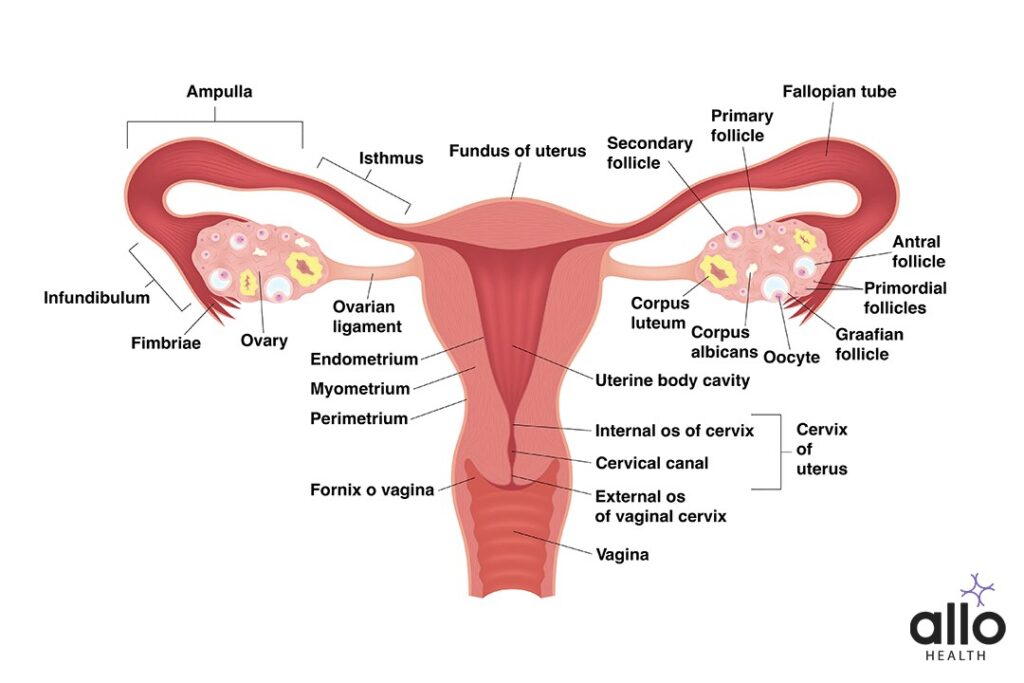Female Reproductive Organs

Allo Health is dedicated to personalized well-being, offering support and trusted information tailored to individual health goals. The platform emphasizes human-generated content, led by a distinguished medical team of experts, including physicians and sexual health specialists. Their commitment to credibility involves rigorous fact-checking, authoritative research, and continuous updates to ensure accurate, up-to-date information. Allo Health's unique approach goes beyond conventional platforms, providing expert-led insights and a continuous commitment to excellence, with user feedback playing a crucial role in shaping the platform's authoritative voice.

A Psychotherapist with Clinical specialization, working for over seven years now. Areas of specialization range from Anxiety-related disorders, Mood-related disorders, Personality disorders, Sexual dysfunctions & other mental health issues.
Why This Was Upated?
Our experts continually monitor the health and wellness space, and we update our articles when new information became available.
Updated on 17 April, 2024
- Article was updated as part of our commitment to diversity, equity, and inclusion.

"The following blog article provides general information and insights on various topics. However, it is important to note that the information presented is not intended as professional advice in any specific field or area. The content of this blog is for general educational and informational purposes only.
Book consultation
The content should not be interpreted as endorsement, recommendation, or guarantee of any product, service, or information mentioned. Readers are solely responsible for the decisions and actions they take based on the information provided in this blog. It is essential to exercise individual judgment, critical thinking, and personal responsibility when applying or implementing any information or suggestions discussed in the blog."
Organs Of The Female Reproductive System
The female reproductive system is a complex and vital part of the female anatomy. It is responsible for producing eggs, regulating the menstrual cycle, and supporting the growth of a fetus during pregnancy. Understanding the female reproductive organs and their functions is important for maintaining reproductive health.
Female Reproductive Organs

Ovaries
The female ovaries are reproductive organs located in the pelvis and are responsible for the production of eggs, as well as the secretion of hormones that regulate a woman’s menstrual cycle and overall reproductive health.
The primary function of the ovaries is to release eggs (ovulation) in a process called the menstrual cycle. This cycle is typically 28 days long and is regulated by hormones produced by the hypothalamus and pituitary gland. Ovulation occurs when a mature egg is released from one of the ovaries and travels down the fallopian tube, where it may be fertilized by sperm.
In addition to releasing eggs, the ovaries also produce hormones such as estrogen and progesterone. Estrogen is responsible for the development of female secondary sexual characteristics, such as the growth of breasts and the widening of hips. It also regulates the menstrual cycle by thickening the endometrial lining in preparation for pregnancy. Progesterone helps to maintain the endometrial lining and prepares the body for pregnancy by suppressing ovulation and thickening the cervical mucus to prevent fertilization.
The ovaries play a crucial role in the reproductive health of women and any issues with the ovaries can impact a woman’s ability to conceive.
Fallopian Tubes
The female fallopian tubes, also known as uterine tubes or oviducts, play a crucial role in the female reproductive system. These delicate tubes are lined with cilia and mucus-secreting glands, and they connect the ovaries to the uterus.
Ovum Transport
One of the primary functions of the fallopian tubes is to transport the ovum (egg) from the ovaries to the uterus. The cilia in the tubes help to move the egg along, while the mucus helps to keep the egg hydrated and protected.
Fertilization
The fallopian tubes are also the site of fertilization, where the sperm meets the egg. The cilia in the tubes help to guide the sperm to the egg, and the mucus helps to protect the sperm as it travels. If fertilization occurs, the fertilized egg then travels down the fallopian tube and into the uterus, where it can implant in the uterine lining and develop into a fetus.
Secretion of Hormones
The fallopian tubes also play a role in hormone secretion. The tubes secrete hormones such as follicle-stimulating hormone (FSH) and luteinizing hormone (LH), which play a role in regulating the menstrual cycle and promoting ovulation.
Barrier Function
The fallopian tubes serve as a barrier to prevent the fertilized egg from implantation in the wrong location, such as the fallopian tube itself. This helps to ensure that a pregnancy develops in the safest possible location, which is the uterus.
Uterus
The uterus is a vital female reproductive organ that plays a crucial role in pregnancy and childbirth. This pear-shaped muscular organ is located in the pelvic region and is essential for the growth and development of a fetus.
Nourishing Environment
One of the primary functions of the uterus is to provide a nourishing environment for the developing fetus. The inner lining of the uterus, known as the endometrium, thickens and becomes rich in blood and nutrients in preparation for the implantation of a fertilized egg. Once the egg is implanted, the uterus provides the necessary conditions for the growth and development of the fetus, including a warm and protected environment, adequate blood flow, and essential nutrients.
Labor and Delivery
The uterus also plays a critical role in labor and delivery. During this process, the uterus contracts, helping to push the fetus through the birth canal and into the world. The uterus is made up of several layers of muscle, which are designed to contract and expand in order to accommodate the growing fetus and assist in delivery.
Menstrual Cycle
The menstrual cycle is a series of changes that occur in a woman’s body over the course of a month, including the shedding of the endometrium. This cycle is controlled by hormones produced by the ovaries and the hypothalamus, which regulate the growth and shedding of the endometrium.
In addition to its reproductive functions, the uterus also has several non-reproductive functions. For example, it is involved in regulating blood flow and blood pressure in the body, and it helps to maintain the pelvic floor, which provides support for the bladder, rectum, and other organs in the pelvic region.
Cervix
The cervix is an important part of the female reproductive system, playing several crucial roles in fertility and pregnancy. Understanding the functions of the cervix can help women better understand their own reproductive health and make informed decisions about their bodies.
Barrier function
The cervix acts as a barrier between the vagina and the uterus, preventing foreign objects and bacteria from entering the uterus and potentially causing harm to the developing fetus.
Facilitation of sperm transport
During intercourse, the cervix dilates slightly, allowing sperm to enter the uterus and begin their journey towards the fallopian tubes, where fertilization can occur.
Production of cervical mucus
The cervix produces a special type of mucus, called cervical mucus, which helps to transport sperm from the vagina to the uterus. Cervical mucus also helps to protect the sperm from the acidic environment of the vagina.
Control of dilation during labor
The cervix plays an important role in the birthing process, dilating and thinning out to allow the baby to pass through the birth canal. This dilation is controlled by hormones produced by the body, such as oxytocin and prostaglandins.
Protection of the fetus
The cervix provides a physical barrier that protects the developing fetus from harm, such as from falling or from objects hitting the uterus. Additionally, the cervix may close up in response to uterine contractions or to prevent premature labor.
Vagina
The vagina is a crucial reproductive organ in the female anatomy, and it has several important functions. These functions include sexual pleasure, childbirth, menstruation, and providing a safe and healthy environment for the growth and development of a fetus.
Sexual Pleasure
The vagina plays a crucial role in sexual pleasure for women. Its walls contain nerve endings that can provide a significant amount of sensation during sexual arousal and intercourse. The vagina can also expand and contract, which enhances sexual pleasure and helps to facilitate sexual intercourse.
Childbirth
The vagina is also an important birth canal, allowing a baby to pass from the uterus to the outside world during delivery. The vagina is capable of expanding and contracting, which makes it possible for a baby to pass through the narrowest part of the canal, known as the cervix, and into the birth canal. During childbirth, the vagina stretches and widens to accommodate the head of the baby and eventually the entire body.
Menstruation
The vagina is also a part of the female reproductive system that plays a role in the menstrual cycle. During the menstrual cycle, the walls of the uterus shed their lining, and the blood and tissue are expelled from the body through the vagina.
Safe and Healthy Environment
The vagina is home to a delicate balance of bacteria and other microorganisms that help to maintain a healthy and balanced environment. This balance is important for preventing infections, such as yeast infections, bacterial vaginosis, and other sexually transmitted diseases. Additionally, the vagina produces a natural lubricant that helps to keep the tissues healthy and prevents irritation and discomfort during sexual activity.
Vulva
The vulva is a complex and multi-functional part of the female anatomy that plays a crucial role in sexual pleasure, childbirth, and urinary function. It is located between the legs and consists of several structures, including the mons pubis, labia majora, labia minora, clitoris, and vaginal opening.
Mons Pubis
The mons pubis, also known as the “mons veneris,” is a fatty tissue covered area located at the front of the pubic bone. It protects the pubic bone and provides cushioning during sexual intercourse.
Labia Majora
The labia majora, which means “large lips,” are two fleshy, hair-covered folds that surround the vaginal opening and protect the other vulvar structures.
Labia Minora
The labia minora, or “small lips,” are thin, hairless folds of skin that lie just inside the labia majora. They contain numerous nerve endings and play a crucial role in sexual pleasure by providing stimulation to the clitoris and vaginal opening during sexual arousal.
Clitoris
The clitoris is a highly sensitive and sexually responsive structure located at the top front of the vulva. It is the only part of the body with the sole purpose of providing sexual pleasure.
Vaginal Opening
The vaginal opening, also known as the introitus, is the entrance to the vagina. It expands during sexual arousal and childbirth to accommodate penetration and delivery, respectively. The vaginal canal, which lies behind the vaginal opening, is lined with mucous membranes and is capable of producing natural lubrication to facilitate sexual intercourse.
Urinary Function
The vulva also plays a crucial role in urinary function. The urethral opening, located above the vaginal opening, allows for the elimination of urine from the body. Additionally, the vulva provides support for the bladder, uterus, and rectum, helping to maintain their proper position within the pelvis.
Medical Conditions Affecting Female Reproductive Organs
Female reproductive organs are complex and delicate structures that play a vital role in human reproduction and overall health. However, these organs are susceptible to various medical conditions that can cause discomfort, pain, and infertility.
Endometriosis
Endometriosis is a condition in which the tissue that normally lines the inside of the uterus grows outside of it. This can cause severe pain, heavy menstrual bleeding, and infertility. Endometriosis is believed to affect up to 10% of women of reproductive age.
Polycystic Ovary Syndrome (PCOS)
PCOS is another common condition affecting female reproductive organs. It is characterized by the growth of small cysts on the ovaries and an imbalance of hormones that can lead to irregular menstrual cycles, weight gain, and infertility. PCOS affects up to 10% of women of reproductive age.
Fibroids
Fibroids are non-cancerous growths that develop in the uterus and are common in women of reproductive age. They can cause heavy menstrual bleeding, pain, and infertility. Fibroids are estimated to affect up to 80% of women by the age of 50.
Pelvic Inflammatory Disease
PID is an infection of the female reproductive organs that can cause pain, fever, and infertility. PID is often caused by sexually transmitted infections such as chlamydia and gonorrhea, and can lead to scarring and damage to the fallopian tubes.
Yeast Infections
Yeast infections are caused by an overgrowth of the fungus Candida, which is normally found in the vagina. Symptoms of a yeast infection include itching, burning, and discharge. Yeast infections can be treated with antifungal medications, either over-the-counter or prescription.
Bacterial Vaginosis
Bacterial vaginosis is a condition caused by an imbalance of bacteria in the vagina. Symptoms of bacterial vaginosis include discharge, odor, and itching. Bacterial vaginosis can be treated with antibiotics.
Vulvodynia
Vulvodynia is a condition that causes chronic pain in the vulva, the area surrounding the vagina. The cause of vulvodynia is unknown, but it is thought to be related to nerve problems. Treatment for vulvodynia may include medication, physical therapy, and nerve blocks.
Vaginitis
Vaginitis is an inflammation of the vagina. There are several causes of vaginitis, including yeast infections, bacterial vaginosis, and trichomoniasis. Vaginitis can be treated with medications, including antifungals, antibiotics, and anti-inflammatory drugs.
Cervicitis
This is an inflammation of the cervix, often caused by a bacterial or viral infection. Symptoms include discharge, pain, and bleeding. Treatment usually involves antibiotics or antivirals.
Cervical Dysplasia
This is a precancerous condition that occurs when the cells of the cervix change and grow abnormally. It is often caused by the HPV virus and can be treated with procedures like cryotherapy or laser therapy.
Cervical Incompetence
This occurs when the cervix opens too soon during pregnancy, leading to premature delivery or miscarriage. Treatment options include cervical cerclage (suture placement) or cervical pessary (a device that provides support to the cervix).
Uterine Fibroids
Uterine fibroids are benign (non-cancerous) growths that develop in the uterus. These growths can range in size from tiny seedlings to massive tumors and can cause symptoms such as heavy bleeding, pain during intercourse, and infertility. Endometriosis is a condition in which the endometrial tissue that normally lines the inside of the uterus grows outside of it, causing pain and infertility.
Uterine Prolapse
Uterine prolapse occurs when the uterus drops into the vaginal canal due to a weakened pelvic floor. This condition is more common in women who have given birth and can lead to discomfort, pain, and urinary incontinence. Adhesions, also known as Asherman?s syndrome, occur when scar tissue forms inside the uterus, causing it to stick to other organs and potentially leading to infertility.
Ovarian Torsion
Ovarian torsion is a condition in which the ovary twists on itself, causing pain and discomfort. This condition can also cause damage to the blood supply of the ovary, leading to the death of the ovary tissue.
Reproductive Cancers
Cervical Cancer
This is one of the most common cancers affecting the female reproductive system. It occurs when abnormal cells in the cervix, which is the lower part of the uterus, grow out of control. Cervical cancer can often be prevented through regular screening tests, such as a pap smear, which can detect pre-cancerous cells before they turn into cancer.
Ovarian Cancer
Ovarian cancer is another cancer that affects the female reproductive system. It starts in the ovaries, which are the two small, almond-shaped organs located on either side of the uterus. Ovarian cancer can be difficult to diagnose because its symptoms are often vague and can be mistaken for other conditions. However, if diagnosed early, ovarian cancer can be treated effectively.
Uterine Cancer
Uterine cancer, also known as endometrial cancer, starts in the uterus, which is the hollow, pear-shaped organ in a woman’s pelvis. It is the most common type of cancer that affects the uterus and can often be treated if caught early.
Vaginal Cancer
Vaginal cancer is a rare type of cancer that occurs in the vagina, which is the muscular tube that connects the uterus to the outside of the body. The exact cause of vaginal cancer is not known, but certain risk factors have been identified, such as exposure to diethylstilbestrol (DES) before birth and human papillomavirus (HPV) infection.
Sexual health is as important as physical and mental health. In most cases, one consultation can go a long way. Personalised, discreet, and judgement-free treatment at your fingertips – book an online consultation with one of Allo?s leading experts.







































